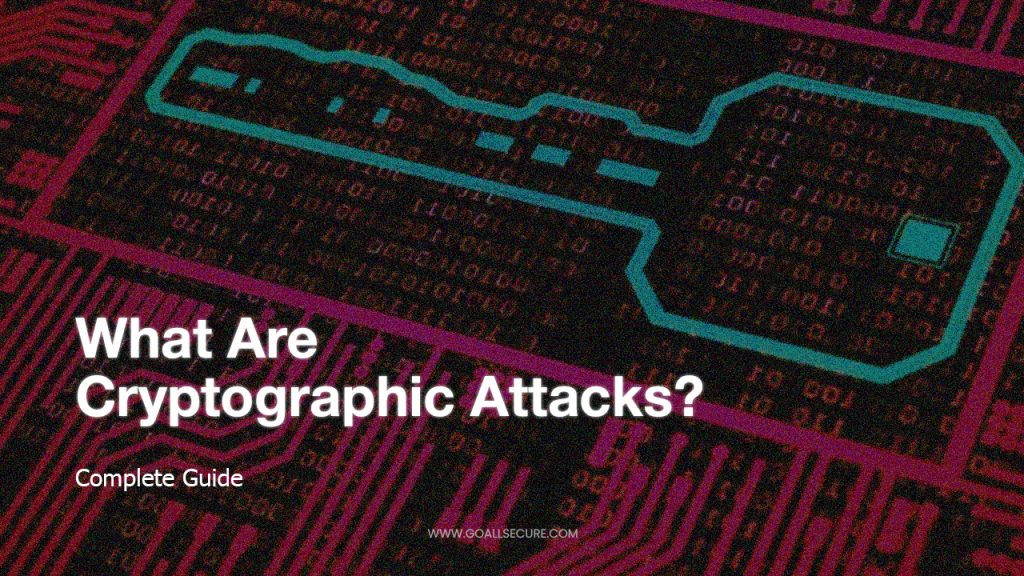The ongoing risks of possible breaches are soaring high every single day. When you add cryptographic attacks to the mix, it feels as if nothing is really safe. We say this because cryptographic techniques were meant to make encryption stronger, but the reality of cyber attacks points towards the fact that they can still be broken. You need to understand cryptography better to understand cryptographic attacks and the risks involved. It is a crucial security element in the quickly evolving realm of digital storage and communication. The three main components of cryptography are key, data, and key-assisted encryption and decryption of the data. Cryptography secures data by using a variety of encryption algorithms. The whole point of encryption is to make things so hard that trying out every possible key takes a lot of time. This is where malicious threat actors have levelled up; they attempt to crack the key and use more sophisticated techniques to steal data from the network. Threat actors are circumventing its security by identifying flaws in a cryptographic system’s code, cypher, cryptographic protocol, or key management mechanism. This blog will examine common types of cryptographic attacks, discuss how they occur, and provide doable countermeasures to bolster your security.
Understanding Cryptography and Cryptographic Attacks
The process of hiding or encoding data so that only the intended recipient may read it is known as cryptography. For thousands of years, the practice of cryptography has been utilised to encode information. It is still employed today in e-commerce, bank cards, computer passwords, and many other fields. Although its roots can be found in ancient Egyptian hieroglyphics, cryptography is still essential for protecting data while it is being transmitted and keeping unauthorised parties from reading it. It employs mathematical ideas and algorithms to convert messages into hard-to-decipher codes to safeguard credit card transactions, email, web browsing, data privacy, and digital signatures. Cryptology, another name for this cybersecurity technique, blends computer science, engineering, and mathematics to produce intricate codes that conceal a message’s actual meaning.
The encryption and decryption of data are made possible by modern cryptography techniques, which include cyphers, algorithms and encryption keys. Contemporary cryptosystems are thought to be nearly impenetrable. That is why a popular definition of cryptography explains it as information coding to guarantee that a message may only be read and processed by the intended recipient. But with cryptographic attacks on the rise, this seems reaching. Cybercriminals today are taking advantage of flaws in keys to exploit your data. This purposeful attempt to undermine the security of cryptographic systems, including encryption methods or algorithms, with the goal of obtaining unauthorised access to private data is known as a cryptographic attack. Cryptographic attacks can decrypt a message and reveal its plaintext content by targeting the flaws in encryption algorithms.
Notable Cryptographic Attacks
- Poodle
- Beast
- Lucky13
- Robot
- Heartbleed
- Drown
- Crime
Popular Terms Associated with Cryptography
After describing cryptography and cryptographic attacks, let’s address the fundamental terminologies associated with them.
Pillars of Cryptography
Current cryptography aims to achieve the following goals:
- Confidentiality
- Integrity
- Non-repudiation
- Authentication
- Secure communication
Understanding these is especially important when dealing with a cryptographic attack since defensive procedures that satisfy some or all of the abovementioned requirements are referred to as cryptosystems.
Plaintext
Plaintext refers to the text that is to be transmitted and is readable by most people.
Ciphertext
After the encryption process transforms this plaintext into an unintelligible format, it is referred to as “Ciphertext.”
With this ciphertext, one can securely communicate data over unsecured channels without worrying about it being intercepted. After successfully transmitting it, the recipient must decrypt it to recover the plaintext again.
Two Types of Encryptions
There are two types of encryption: symmetric and asymmetric encryption. When the same key is used to encrypt and decrypt a message, it is called the “symmetric encryption” technique. If different keys are used for both the encryption and decryption of messages, it is an “asymmetric encryption” method.
Codes and Cyphers
They are similar to locks and keys. Data is encrypted using codes and cyphers so that only the appropriate key can decode it.
Cryptographic Algorithms
Cryptography uses encryption and decryption to securely connect computer systems, devices, and apps. It does so by using a collection of processes called cryptographic algorithms. The algorithm used in cryptography is a mathematical formula that converts data into an unreadable format. It is only understandable by someone who has the particular decryption keys. Cryptographic algorithms are employed in digital signatures, authentication, and data encryption.
Cryptosystems
Cryptographic algorithms and protocols protect sensitive information and guarantee safe communication. A cryptosystem’s three primary components are key management, decryption, and encryption. To properly handle key management, cryptosystems use methods like symmetric cryptography (shared secret keys) or asymmetric cryptography (public and private keys).
Key Management System
Key management refers to schemes used to manage keys in cryptography. Any weakness in a key management system can give rise to a cryptographic attack vector.
Cryptanalysis
Cryptanalysis is the method by which a cryptographic attack is executed. It resembles the instruments used by robbers to cut locks. Cyber threat actors deploy cryptoanalysis to access the plaintext without possessing the key to decrypt the ciphertext.
Types of Cryptographic Attacks
The idea of secrecy, integrity, and authenticity are all preserved when information is transmitted safely and securely, thanks to cryptography. After reviewing the fundamentals of cryptography, we know how the entire process takes place. It is now time to look at the various kinds of attacks that could occur. First up is the broad classification of cryptographic attacks into two categories:
- Active Attacks
- Passive Attacks
Active Attacks
Cryptographic attacks classified as “active” occur when an attacker tries to modify, damage, or interfere with a system’s or network’s regular operation. To put it directly, active cryptography attacks depend on changing the transmission of data. In this instance, the attacker manipulates the data in addition to gaining access to it. Active attacks can be more harmful than passive attacks, which only entail observing or listening in on a system or network since they entail the attacker taking actual action against the target system or network.
Passive Attacks
A passive attack keeps an eye on, watch, or exploit system data for specific purposes. The data remains unaltered and has no effect on the system resources. Due to the covert nature of passive attacks, it is challenging for the victim to identify them. A passive attack aims to obtain data or examine open ports and network weaknesses. Passive attacks are less dangerous because they don’t alter or modify data.
These attacks can be further categorised into different groups based on the type of cryptography system utilised and the information that the attacker has access to. Both passive and active cryptography attacks fall within the following primary categories of cryptography attacks:
Brute Force Attack
A straightforward and uncomplicated cryptographic attack known as a brute force attack attempts every possible password or key to access data files. Cybercriminals carry out such attacks by methodically guessing the passwords that safeguard cryptographic data using massive computational power. In a cryptographic system, public and private keys are essential for both encrypting and decrypting data. A cybercriminal, using a brute force attack, tries a variety of private keys in an attempt to decrypt data or a message that is encrypted. There will be 256 (i.e., 28) potential keys if the key size is 8 bits. For the cybercriminal to attempt all 256 possible keys in this attack strategy, they need to know the algorithm, which is typically available as open-source programmes. Therefore, in these kinds of attacks, the length of the key dictates how long it takes to find the password. Brute force attacks can, thus, only be successful if sufficient time is allowed. Since there are twice as many possible combinations with a longer key, the amount of time needed to launch the Brute force attack successfully doubles.
Chosen Ciphertext Attack
The cybercriminal examines a selected ciphertext that matches the plaintext in this attack model. The goal of the attack is to get a secret key or system information. The attacker tries to deduce the key by examining the selected ciphertext and comparing it to the plaintext.
Man-In-The-Middle (MITM) Attack
An MITM attack occurs when a third party listens in on or intercepts a discussion between two participants. This can happen on unprotected networks or compromised devices, allowing hackers to alter data, eavesdrop, or introduce malicious content. In this case, the attacker reads or modifies messages that are being sent between two parties, intercepts them, and then forwards them. Envision a postal worker that, without your knowledge, opens, reads, and then discreetly seals and delivers your mail. This kind of attack involves an attacker using a secured channel to intercept a message or key between two parties in communication. This hints towards the fact that perhaps encryption is insufficient on its own.
Side-channel Attack
Rather than relying on flaws in the algorithm itself, this kind of attack uses information gleaned from the cryptographic system’s actual physical implementation. Side-channel attacks target information revealed during cryptographic operations, like power or time consumption. Attackers can figure out the encryption keys by looking at this tiny leakage. Attackers may employ additional strategies in addition to mathematical methods, such as monitoring radiation emissions, power consumption, and processing time. Using this information, the attacker can use inverse reasoning to determine the “keys” to an algorithm by merely measuring the heat generated during an attack. Timing attacks, power analysis attacks, electromagnetic attacks, and other attacks are examples of side-channel attacks.
Known Plaintext Attack
Using information-gathering tactics, a cybercriminal finds or figures out the plaintext of some parts of the ciphertext in this attack method. Cybercriminals who carry out a known plaintext attack possess both the plaintext data required to create the ciphertext and a copy of the already encrypted communication, unlike attacks that require ciphertext. With this knowledge, the attacker can launch more attacks and decrypt weak encryption schemes. After that, he must reverse engineer the “key” in order to decode subsequent communications that employ the same “key” and method.
Chosen Plaintext Attack
Unlike the known plaintext attack, the chosen plaintext attack involves an attacker taking a chance by selecting a plaintext that corresponds with the generated ciphertext. Then, they can decrypt further messages by examining both words to obtain the key and understand more about the encryption procedure.
Statistical Attack
These attacks exploit statistical flaws in encryption systems, including floating-point weaknesses and the inability to generate random numbers. Statistical attacks aim to take advantage of weaknesses in the hardware or operating systems that contain the functional cryptography instrument.
Replay Attack
Cryptographic algorithms lacking temporal protections are vulnerable to replay attacks. Here, cybercriminals listen in on two persons with encrypted communications, ask for confirmation, and then replay the message to start a new session. A “replay attack” involves the attacker capturing data and sending it back to the recipient, perhaps including authentication data. As a result, the attacker gains unauthorised access by tricking the recipient. One of the most crucial defences against “replay attacks” is timestamping.
Birthday Attack
A birthday attack is when someone launches a cryptographic attack by taking advantage of the mathematical formula for the probability theory behind the famous birthday problem. This attack is used in cryptography to locate collisions in a hash function. An attacker attempts to find two distinct input messages that result in the same hash value, a phenomenon known as a collision. During a birthday attack, an attacker can trick a system into thinking that two additional notes are the same by identifying a collision. They are able to crack a password hash or fake a digital signature, for example. Birthday attacks are a severe security risk since they are comparatively simple to carry out and have the ability to compromise a number of cryptographic systems.
Cipher-only Attack
In a “cipher-only” attack, the attacker is aware of the ciphertext of several communications that have all been encrypted with the same technique. Finding the “key,” which can be used to decrypt all messages, is the attacker’s goal. This attack is one of the simplest to carry out since it is simple to sniff out the ciphertext and execute due to a lack of understanding of the encryption process.
What Weaknesses Do Cryptographic Attacks Exploit?
Contemporary cryptographic attack approaches are getting more sophisticated and are bypassing even the unbreakable shields. Attackers can reverse-engineer hashed data and uncover the actual information by taking advantage of weaknesses in hash algorithms that are either obsolete or insufficient. But as more and more organisations are looking towards cryptography to safeguard their data and communications, it’s critical to maintain the security of keys. A single flaw can lead to legal action, penalties, harm to one’s reputation, and loss of clients and investment. Attackers can use these flaws to undertake cryptographic attacks, evade encryption, alter data, or obtain unauthorised access to encrypted data. Possible flaws that a threat actor might exploit include the following:
- Weak keys
- Incorrect use of keys
- Reuse of keys
- Insider threats
- Non-rotation of keys
- Inappropriate storage of keys
- Lack of resilience
- Inadequate protection of keys
- Weak encryption algorithms
- Insecure movement of keys
- Lack of audit logging
- Erroneous implementation of cryptographic protocols
- Manual key management processes
Steps on How to Prevent Cryptographic Attacks?
Cryptographic attacks seriously threaten sensitive data security, so preventive, solid measures are needed to guard against breaches. Putting good security measures into practice requires a diversified approach. Cryptography is one effective technique for preventing data breaches, but it’s only as powerful as you allow it to be. We all understand that the likelihood of a successful breach drops with each additional layer of security you install. The more precautions you take, the stronger your defences against cryptographic system threats will be. The following are essential actions that you can take to improve your cryptosystem:
1. Implement Powerful Encryption
Choose robust and extensively tested encryption algorithms and protocols, such as RSA or the Advanced Encryption Standard (AES), to reduce the probability of successful attacks. Strong encryption ensures that cryptographic systems can withstand even the most sophisticated attacks.
2. Employ Sturdy Key Management
Proper key management procedures are essential to prevent unwanted access to encryption keys. Encryption keys must be generated, kept, and disseminated securely. To improve security, consider implementing key rotation and revocation procedures.
3. Deploy Frequent Security Upgrades
Apply security patches and upgrades to keep encryption software and systems current. This aids in addressing any known flaws or vulnerabilities in the encryption procedure.
4. Use Multi-factor Authentication
MFA should be used because it can lessen the impact of cryptographic attacks by providing an additional layer of authentication. Multi-factor authentication asks users to provide various kinds of information, such as passwords and fingerprints, to reduce unwanted access.
5. Keep Your Cryptographic Keys Safe
Keep your encryption keys secure to stop unwanted individuals from accessing your data. To reduce security risks, you should also refrain from keeping keys in unencrypted format.
6. Invest in Antivirus and Malware Protection Software
These programs can assist in identifying and blocking malicious malware that tries to undermine your encryption.
7. Educate Your Employees
Human error is a significant factor in many cryptographic system attacks, and it is no surprise. Ensure that all members of your team are familiar with how to operate your systems safely. This includes keeping passwords private, avoiding dubious links, and being aware of typical phishing techniques. To prevent unwanted access, train them to be on the lookout for any phishing efforts and avoid clicking on dubious files, links, or videos.
In Conclusion
Attacks using cryptography pose a severe risk to any organisation’s security. They are very dangerous and challenging to tackle. However, businesses can prevent data breaches and communication security breaches by being aware of the different kinds of cryptographic attacks and implementing preventative measures. Investments in cryptographic solutions are already increasing; according to the latest survey, the market for encryption management solutions will grow by 79 per cent by 2025. If you want your business to be secure against these attacks, reach out to GoAllSecure. We’ll safeguard your online safety and give you a strong foundation in cryptographic defence. Our team will be a priceless asset to your organisation, helping you comprehend and avoid cryptographic threats. Don’t hesitate to get in touch with us at +91 85 2723 7851 or +44 20 3287 4253 if you have any questions concerning cryptography or would like more information about how it is used in the digital economy.

















 TRAVEL & HOSPITALITY
TRAVEL & HOSPITALITY HEALTHCARE
HEALTHCARE RETAILS & ECOMMERCE
RETAILS & ECOMMERCE BANKING & FINANCIAL
BANKING & FINANCIAL AutoMobile
AutoMobile MANUFACTURING
MANUFACTURING FOOD
FOOD EDUCATION
EDUCATION



